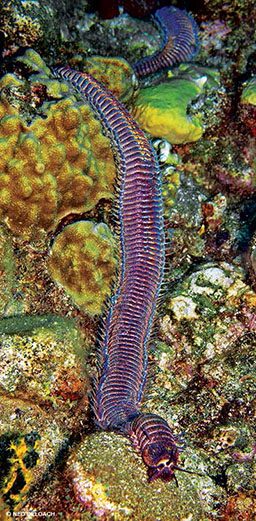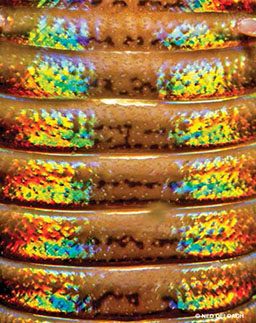Three South Africans, a Frenchman, a Norwegian and a Turk bail out of a boat backward at night. Although it may sound like the beginning of a bad barroom joke, it’s actually the beginning of an amazing real-life adventure.
The divers, guests at a resort in Lembeh Strait, Indonesia, decided at the last minute to organize a night dive to search for a legendary sea monster said to live in the depths of Teluk Kembahu Bay. I wasn’t about to miss out on the escapade. Once underwater, I fell into formation behind the others, following our Indonesian guide down a sand slope. At 40 feet the guide stopped at the edge of a rubble patch and swept his beam across the bottom. As if on cue, a giant segmented worm — far larger and more fearsome than expected — sprang out of the sand with the speed of a cobra. The team backpedaled in unison.
Every eye locks onto the creature’s claim to fame and the source of its common name: a twin set of retractable jaws, snapped wide to the side like switchblades retooled with curved tips and serrated edges — perfect for maximum carnage. Agitated by the flood of lights, the worm disappears back into the sand as suddenly as it had appeared.

After collecting our wits, we begin switching off our lights as instructed in the boat briefing until only the glow of the guide’s beam, filtered through his fingers, illuminates the sand. The worm surges up again, this time stretching an arm’s length above the bottom before plunging back into the sand like a piston, where it sits with the tip of its head exposed and its angry jaws flared. No one moves. Finally, our guide motions us closer, and we creep forward, one at a time, and stare down at the jaws designed for violent death.
By fate, giant tropical worms such as this one, now known universally as Bobbit worms, came to the public’s attention shortly after the 1993 story broke about Lorena Bobbitt taking revenge on her philandering husband in a most memorable way. The name remains a fixture 20 years later, forever vilifying the worm.
Although they’re known worldwide, much about these secretive worms remains a mystery. For starters, even though more than 350 species have been scientifically described in the genus Eunice, a great deal of the early work needs revision. Even for the few Eunice experts around, it is virtually impossible to identify one from a photograph, and it can even be challenging with the specimen in hand. Genus members, all armed with their notorious mouthparts, range from small animals only inches long to titans such as the one we saw in Lembeh. A few collected specimens measure 10 feet in length, and one Australian colossus is reputed to have reached 20 feet. Perhaps unsurprisingly, the worms’ natural history also remains a mystery.
After the other divers lose interest and wander away, I remain kneeling beside the beast, transfixed. I’m particularly intrigued by how the jaws collapse back onto themselves to disappear inside the worm’s fleshy head. No less bewitching is the sheen of rainbow iridescence rippling along its back. In the midst of my reverie, the worm offers a rare gift — a reward for my chronic curiosity — releasing a stream of smoky spawn into the night.
I have an even more memorable Bobbit worm encounter on a subsequent trip to Dominica, a lush volcanic island in the eastern Caribbean. During a safety stop at the top of an offshore pinnacle, my dive guide, Imran, points toward a hole in the reef. Glancing down I see the unmistakable form of a large reef-dwelling Bobbit crawling through the shadows.

In one of those “What was I thinking?” moments, I slip my steel wand beneath its body and lift. The worm comes out without the least bit of resistance. Imran retreats, his eyes bulging. Amazed, I keep lifting until the creature dangles in a great U from my stick. Astonishingly, the famous jaws remain retracted. I slip my upturned hands beneath the belly and watch as it crawls over my palms like a pet corn snake. Measured against my height, the body appears to be at least 6 feet long. I drape the worm across the bottom and snap a portrait before inserting the head inside the hole, where it calmly disappears.
Back aboard the boat, Imran is dancing in disbelief: “That’s crazy, man. You’re lucky to have a face.”
“Yeah,” I answer, still attempting to sort through what just happened myself. “I guess I am lucky.”
Word travels fast on Dominica, and the next morning at least a half dozen disbelievers meet me at the dock. Although few locals on the island dive, everyone has been raised with horror stories about the monster worms inhabiting their waters. In a weird sort of way, you could think of the Eunice worms as island mascots. After retelling my tale for a third time, I retrieve my computer from my room and display the portrait.
“No, mon. Look at dat. It’s obvious de worm is some kind of sick,” one skeptic claims. The others gathered around the screen nod in agreement.
“What else can I say?” I reply. “You can believe it or not.”
© Alert Diver — Q4 Fall 2014